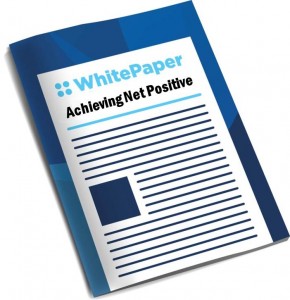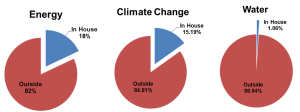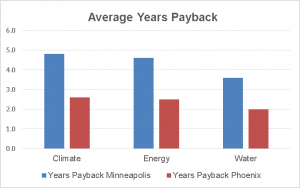Growing our Handprints and Reaching Net Positive with ILI Painted Sunshades
Footprints are negative impacts, the energy, water, climate and other impacts involved in what we do. Every person, product, service and organization creates footprints. Historically, we think of sustainability in terms of reducing our footprint. The problem is that even if we were able to shrink those impacts to zero, we wouldn’t be able to make up for damage already done. If we create positive impacts, called handprints, which exceed our footprints, our net impact would be positive. One of the goals of the International Living Future Institute’s (ILFI’s) Living Product Challenge is to encourage manufacturers to produce products that are net positive. If we do that, we essentially make the world a better place with every product we sell. ILI targeted painted sunshades for our first Living Product certification and is well on its way to achieving net positive products.
The first step in this process is measuring our footprint. Our total footprint is measured using a process called a Life Cycle Assessment (LCA). Dr. Greg Norris, Chief Scientist ILFI and Co-Director, Sustainability and Health Initiative for NetPositive Enterprise (SHINE) and Adjunct Lecturer on Life Cycle Assessment at the Harvard T.H. Chan School of Public Health, prepared ILI’s LCA. He focused on three of the most significant factors in our overall footprint: energy, water and climate impact. All of the inputs are estimated using global standards for each activity throughout the life of the product. For our products, that includes producing the aluminum, transporting it to the extruder, extruding it, transporting it to use, finishing it, shipping it out and everything in between. In our process, the inputs outside our factory make up the majority of our footprint (Figures 1, 2, 3). In order to be net positive, we need to offset the inputs for the entire process, not just at our plant.

Figures 1-3: Manufacturing phase enery, climate change and water impacts are only a small part of our products’ overall footprint.
Creating handprints allows us to offset the impacts of the total life-cycle of our product. We used information from a study performed by John Carmody at the University of Minnesota as the basis for determining the energy, water and climate effects of our products during the use phase (when are products are on a building). We applied data from six cities, multiple sunshade configurations and glazing types for 648 total input reduction scenarios. The point at which our sunshades provide a payback for energy, climate and water usage vary by sunshade size, glazing type climate area. In every case, however, our forecasted savings are greater than the inputs required to make them. In climates where cooling loads are high, the payback time is shorter (Figure 4). Our products have a 20-year finish warranty and an even longer life expectancy. That means that they are essentially net positive when they reach the payback threshold. In other words, the handprints for these products are bigger than their footprints.

Figure 4: Average climate, energy and water paybacks vary by location, but are net positive early in the products’ use phase.
Interested in learning more about the process of measuring our handprint? Please click here to receive a copy of the white paper when it becomes available.





